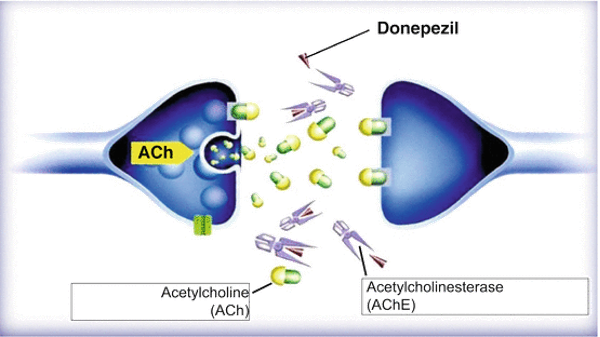Donepezil is a white or almost white crystalline powder and is freely soluble in chloroform, soluble in water and in glacial acetic acid, slightly soluble in ethanol and in acetonitrile, and practically insoluble in ethyl acetate and in n-hexane. Donepezil is a potent, selective, noncompetitive, and rapidly reversible inhibitor of acetylcholinesterase (AChEI) licensed for the treatment of Alzheimer disease (AD) and other types of dementia. The structure of donepezil is showed in figure 1.
 Fig. 1 Structure of donepezil
Fig. 1 Structure of donepezil
Application in the treatment of Alzheimer's disease
Donepezil was first approved to be prescribed in 1996, mainly to delay the progressive worsening of cognitive symptomatology of patients diagnosed with Alzheimer's Disease.
- Introduction of Alzheimer's disease
Alzheimer's disease (AD) is a neurodegenerative disease that usually starts slowly and progressively worsens. AD is the most common cause of dementia — a continuous decline in thinking, behavioral and social skills that affects a person's ability to function independently. Figure 2 shows the physiological structure of the brain and neurons in healthy brain and AD brain [1].
 Fig. 2 The physiological structure of the brain and neurons in healthy brain and Alzheimer’s disease brain
Fig. 2 The physiological structure of the brain and neurons in healthy brain and Alzheimer’s disease brain
- Mechanism of action
The commonly accepted cholinergic hypothesis proposes that a portion of the cognitive and behavioral decline associated with Alzheimer's are the result of decreased cholinergic transmission in the central nervous system.
Donepezil binds reversibly to acetylcholinesterase and inhibits the hydrolysis of acetylcholine, thus increasing the availability of acetylcholine at the synapses, enhancing cholinergic transmission (see Figure 3) [2]. Some in vitro data has suggested that anticholinesterase activity of donepezil is relatively specific for acetylcholinesterase in the brain.
 Fig. 3 Donepezil impedes AChE resulting in an increase of Ach level in the synaptic cleft
Fig. 3 Donepezil impedes AChE resulting in an increase of Ach level in the synaptic cleft
In addition to the above, other mechanisms of action of donepezil are possible, including the opposition of glutamate-induced excitatory transmission via downregulation of NMDA receptors and the regulation of amyloid proteins, which have demonstrated significant effects on the disease process of Alzheimer's. Other possible targets for donepezil may also include the inhibition various inflammatory signaling pathways, exerting neuroprotective effects.
It should be noted that donepezil is used to treat symptoms of AD such as improving cognition and behavior without altering the AD progression.




Comments